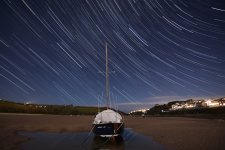Sam Thurston
New member
Good morning everyone,
I'm afraid this is a newbie alert!
I've had my D3200 for two weeks. It's my first DSLR and I love it.
I'd really like to catch some star trails.
I have the standard Nikkor AF-S 18-55mm lens on and it's on 18th. I've taken a quite shot to make sure my frame is right using the following settings;
Focus mode M, programme M, Raw+F, WB bulb, iso 100, Release S, 30" exposure on F 3.5.
The initial shot is exactly as I want it.
I've plugged my timer in set it to 2 hours and hit go.
Left it to it and returned after 2h15m and the camera battery is flat and no picture in the memory. The timer has counted down and that battery is fine. It's a 64gb memory card with one picture (the initial frame) on it.
Does anyone know how long the charge lasts, from fully charged on a single long exposure? Or can anyone point me the right way to catch a star trail in terms a 5 year old would understand.
Thanks in advance, any help great fully received as I'd like to try again tonight whilst I'm somewhere with little light pollution xx
I'm afraid this is a newbie alert!
I've had my D3200 for two weeks. It's my first DSLR and I love it.
I'd really like to catch some star trails.
I have the standard Nikkor AF-S 18-55mm lens on and it's on 18th. I've taken a quite shot to make sure my frame is right using the following settings;
Focus mode M, programme M, Raw+F, WB bulb, iso 100, Release S, 30" exposure on F 3.5.
The initial shot is exactly as I want it.
I've plugged my timer in set it to 2 hours and hit go.
Left it to it and returned after 2h15m and the camera battery is flat and no picture in the memory. The timer has counted down and that battery is fine. It's a 64gb memory card with one picture (the initial frame) on it.
Does anyone know how long the charge lasts, from fully charged on a single long exposure? Or can anyone point me the right way to catch a star trail in terms a 5 year old would understand.
Thanks in advance, any help great fully received as I'd like to try again tonight whilst I'm somewhere with little light pollution xx

